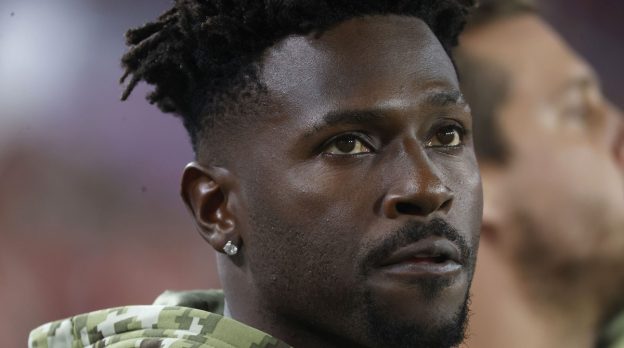Antonio Brown’s striptease was an odd but fitting end to his career with Tampa.
For two years, the Buccaneers sold us the delusion that success in sports is a reflection of a person’s character, and that Brown’s results signify his personal growth. Two of the most important people in the organization, Tom Brady and Bruce Eriens, occasionally promoted this nonsense.
The reality, however, is that when Tampa signed Brown, he was a great soccer player with a history of destructive and disruptive behavior, and a very recent one at that. That’s not progress. The Buccaneers simply confirmed that as long as he remained an excellent player helping the team win, all of his antics didn’t matter much.
All franchises in various playing sports should take a closer look at what happened in Tampa. It’s a prime example of what happens when organizations, consciously or not, view people through the lens of a single thing: what they can or cannot do on the field. In fifteen games for the Buccaneers, Brown had 87 receptions for 1,008 yards with eight touchdowns. This success cemented the illusion that the Bucks didn’t go wrong with him. In reality, however, each catch he made only brought the explosion closer, as the internal dynamics changed with it. At first, Brown needed Tampa to support him in his time of need. But the better he played, the closer the playoff games came, the more he believed Tampa needed him now.
That Sunday, Brown stopped being a great soccer player. It was then that Brady said: “I think everyone should do what they can to help him with what he really needs.” Those are beautiful words and beautiful sentiments, and Brady seemed sincere when he said it. But the quarterback and the team seemed to convince themselves that soccer was helping Antonio, when in fact it was just letting him ignore his serious problems. Sure, he was accused of a lot of transgressions. But he was still a productive player. The rest was–Brown used that word repeatedly–the usual “drama.
By signing Brown, the Buccaneers got what they deserved. And what they themselves created. A second chance (and for him, it was his fourth) isn’t just a second chance. A chance is just a start. People have to be honest with themselves about their failures, and acknowledge them every day until admitting failure becomes a necessary condition of their existence. Tampa has never tried to do that. Instead, in October 2020, Eriens told Peter King of NBC Sports, “If he screws up once, he’s gone.” That sounded great about the new star, but in reality it was ridiculously superficial. Antonio Brown has real problems. Saying, “Don’t do that again!” – is not to help him solve them.
This year, when Brown was suspended for three games for purchasing a fraudulent COVID-19 vaccination certificate, Eriens was again asked about the zero-tolerance policy. The answer was equally feeble.
“I absolutely don’t care what people think,” the coach replied. – “The only thing I care about is my soccer team and what’s best for it.”
It was the classic tirade of a soccer coach pretending to be a tough guy: cowardice covered by arrogance. In this way, Eriens was simply trying to scare off anyone who would try to ask a question, and in doing so, he implicitly rejected the legitimacy of such questions as well.
He had plenty of mature ways to answer the question. He could have said that the questions were fair, but he changed his mind. He could have said that he believed in zero tolerance when Brown was signed, but he thought a lot about it and realized he shouldn’t have taken such a radical position. He could have said he didn’t think the fake certificate was enough of a reason to fire him, especially since Brown had the inoculation after all.
Eriens said: “The story changed after what happened. And a lot of things happened last year that made me proud of him.” This got lost in his aversion to criticism and, besides, Eriens didn’t specifically say what exactly “happened last year.”
I think he was referring to Tampa winning the Super Bowl.
By and large, that’s all that happened. Never did Brown show that he had learned any lessons from his misdeeds. He never admitted his mistakes publicly. In January 2020, even before he signed his contract, in an interview with ESPN, he said: “I don’t think I’ve ever had a conflict with any woman. I just feel like I’m a target, anybody can come out against me and say anything, that’s what I’m up against. No support, no ego, no rules. Anyone can go after me for anything. No evidence or anything like that, just words.” During his mandatory pre-Super Bowl press conference, Brown was spared only this: “I’ve been through some things, but that’s life.” He never talked about what he had done, never apologized to anyone. He wasn’t even going to change his behavior. Brown repeatedly brushed off those who asked him questions, saying he just wanted to focus on soccer. And it happened again and again, most recently when he returned from his suspension and accused reporters of wanting to create “drama.”
It’s pretty clear that Brown doesn’t view his misdeeds as mistakes he made, but as something that happened in his life. There was no story of redemption here. There was no personal growth here. It’s just a story about how the Buckeyes squeezed the most out of a man who hadn’t changed in any way.
And who wanted it more than anyone else? Of course. Tom Brady.
Brady was the main reason Brown was able to be in the league again in the first place. After Tom signed with Tampa, Bruce Arians publicly rejected the idea of the scandalous receiver moving to his team. But Brady wanted to play with him and made it happen. And he hardly had to put in too much effort.
Brady seems to genuinely believe he knows better than most how to live in this world. He really seemed to think he could help Brown. Otherwise, would he have lodged the disgraced receiver in his home? No one in the soccer world allowed him as much as Tom Brady. Of course, the quarterback himself didn’t think so at the time. But if he now sits down and thinks, and his love for Antonio is truly genuine, he can see it now. I hope so.
There are various ways in which troubled people can be brought back to their chosen profession. The Buccaneers took a shortcut. It worked on the field, but that’s about it.
This may be the end of Antonio Brown’s career as a professional soccer player. He played at a level worthy of the NFL Hall of Fame, but it is possible that he should have created a museum named after himself. On one wall could hang the jersey he tore on himself in the third quarter of Sunday’s game against the Jets. On another, the outdated helmet he so badly wanted to wear for the Raiders. On the screen is a broadcast from the Steelers locker room, which he streamed on Facebook without the team’s permission. Brown could hang his stats, the bills and debts he refused to pay, the lawsuits filed against him, and quotes from women he mistreated in beautiful frames. And the owners and general managers of all the NFL clubs can come in and look at it all. Then we’ll see who learned what, too.


